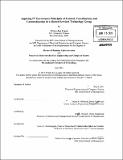| dc.contributor.advisor | Daniel E. Whitney and Roy E. Welsch. | en_US |
| dc.contributor.author | Logan, Wendy-Kay (Wendy-Kay Ruth) | en_US |
| dc.contributor.other | Leaders for Global Operations Program. | en_US |
| dc.date.accessioned | 2011-09-27T18:38:02Z | |
| dc.date.available | 2011-09-27T18:38:02Z | |
| dc.date.copyright | 2011 | en_US |
| dc.date.issued | 2011 | en_US |
| dc.identifier.uri | http://hdl.handle.net/1721.1/66059 | |
| dc.description | Thesis (M.B.A.)--Massachusetts Institute of Technology, Sloan School of Management; and, (S.M.)--Massachusetts Institute of Technology, Dept. of Electrical Engineering and Computer Science; in conjunction with the Leaders for Global Operations Program at MIT, 2011. | en_US |
| dc.description | Cataloged from PDF version of thesis. Pages 93 and 94 are blank. | en_US |
| dc.description | Includes bibliographical references (p. 91). | en_US |
| dc.description.abstract | IT governance focuses on how leadership can be effective and efficient in guiding an organization's use of technology to meet business needs. Over the past decade, IT governance has become a key issue of concern for senior technology leaders around the world. This research suggests that shared services technology groups can leverage appropriately architected IT governance practices given three primary roles played by IT governance to induce appropriate IT-related behaviors: control, coordination, and communication. Specifically, this thesis represents research completed at Raytheon Company's Space and Airborne Systems (SAS) division in partnership with MIT's Leaders for Global Operations (LGO) program. The author worked closely with the Logistics Strategy and Optimization group, which focuses on optimizing business processes and maintaining performance metrics for SAS Logistics. The author led a team to formalize the technology introduction process to increase business unit visibility, knowledge sharing, and reuse by applying traditional IT governance and core process redesign principles. By analyzing Raytheon's technology introduction process through the lens of control, coordination and communication, this research was able to validate the relevance of the framework in a specific shared services environment. An improved technology introduction process is proposed and tested along with recommendations for organizational changes to improve alignment across different business sites. Some recommendations include expanding technology knowledge and oversight through new communication channels, expanding core team responsibilities, and standardizing product development documentation focused on appropriately setting customer expectations. This thesis also documents insights about business unit readiness to adopt shared technologies and provides recommendations for future work focusing on project portfolio management and stakeholder documentation. | en_US |
| dc.description.statementofresponsibility | by Wendy-Kay Logan. | en_US |
| dc.format.extent | 94 p. | en_US |
| dc.language.iso | eng | en_US |
| dc.publisher | Massachusetts Institute of Technology | en_US |
| dc.rights | M.I.T. theses are protected by
copyright. They may be viewed from this source for any purpose, but
reproduction or distribution in any format is prohibited without written
permission. See provided URL for inquiries about permission. | en_US |
| dc.rights.uri | http://dspace.mit.edu/handle/1721.1/7582 | en_US |
| dc.subject | Sloan School of Management. | en_US |
| dc.subject | Electrical Engineering and Computer Science. | en_US |
| dc.subject | Leaders for Global Operations Program. | en_US |
| dc.title | Applying IT governance principles of control, coordination, and communication in a shared services technology group | en_US |
| dc.type | Thesis | en_US |
| dc.description.degree | S.M. | en_US |
| dc.description.degree | M.B.A. | en_US |
| dc.contributor.department | Leaders for Global Operations Program at MIT | en_US |
| dc.contributor.department | Massachusetts Institute of Technology. Department of Electrical Engineering and Computer Science | |
| dc.contributor.department | Sloan School of Management | |
| dc.identifier.oclc | 753563867 | en_US |
